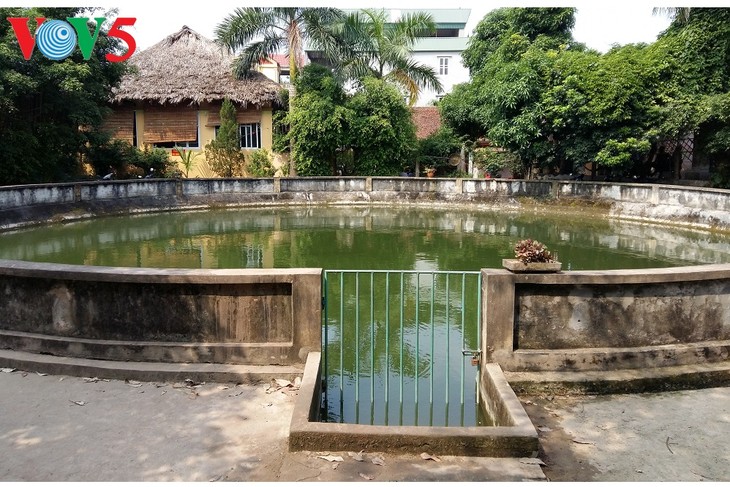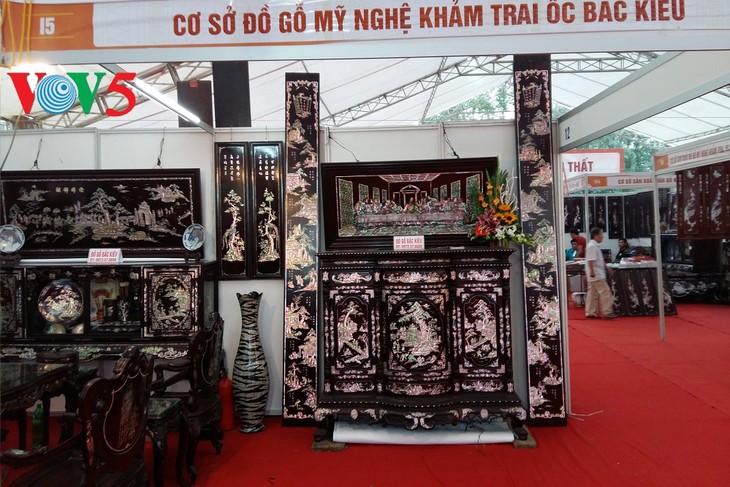(VOVWORLD) - Chuyen My village on the outskirts of Hanoi is famous for mother-of-pearl inlays. Of all the seven hamlets practice the traditional craft, Chuon Ngo has the oldest pearl inlay history - more than 1,000 years.
 Chuon Ngo hamlet’s pond (Photo: Ngoc Anh/VOV5) Chuon Ngo hamlet’s pond (Photo: Ngoc Anh/VOV5) |
Chuon Ngo’s history books say that the pearl inlay craft began in the early 11th century. Truong Cong Thanh, a talented mandarin under the Ly dynasty from 1009 to 1225, was credited as the craft’s progenitor. Chuon Ngo pearl inlay products are widely praised for their sophisticated features and decorative details.
“There are seven hamlets in Chuyen My village but Chuon Ngo, the source of the craft, seems to stand apart. Many people from other places have come to my hamlet to learn the occupation but can gain only partial expertise. Their level has never attained to that of the village-born people. Pearl inlay connoisseurs can easily recognize whether or not a product is made by Chuon Ngo villagers due to its striking beauty and soulfulness,” said villager Nguyen Van Lang.
Chuyen My products are made from local snail shells and pearl and imported materials from China, Thailand, Singapore, and Indonesia.
Artisan Vu Van Vinh of Thuong hamlet said: “Chuyen My now has 20 artisans. Befiting the demands of the handicraft, workers must be dexterous, creative, and have a keen aesthetic sense. Our materials are pearl and snail shells which after being sharpened will be cut into prepared shapes and placed into the carved wood boards. The product will then be ground and polished. To differentiate between products made of snail and clam shells, one must look to the color. Snail shell products reflect different colors from each angle while pearl shell items have only one color from any angle. 10 kilograms of raw pearl shells are processed into 3 kilos of materials and 10 kilos of raw snail shells give us only 2 kilos of processed materials.”
 Pearl inlay products made by Chuyen My villagers (Photo: Ngoc Anh/VOV5) Pearl inlay products made by Chuyen My villagers (Photo: Ngoc Anh/VOV5) |
Over the past 30 years, the craft has been strongly developed. In Chuyen My village roadside shops sell pearl inlay items of various shapes and designs. Some hamlets focus on supplying snail and pearl materials. Some specialize in pearl inlay paintings. Some are specialized in woodwork, horizontal lacquered boards, and parallel sentences inlaid with pearl. The number of skilled workers is on the rise. Dozens of companies and workshops have been set up, creating jobs for thousands of villagers.
Artisan Nguyen Duc Biet of Chuon Ngo hamlet said: “We used to have a lot of skilled artisans and craftsmen who traveled nationwide and even abroad to teach how to inlay mother of pearl. On the occasion of the 1000th anniversary of Thang Long-Hanoi in 2010, I created a picture called “Royal proclamation’s procession to the capital city” which was displayed at the Botanical Garden in Hanoi. The picture depicting King Ly Thai To’s decision to relocate Vietnam’s capital city in Thang Long, the former name of Hanoi. The work is more than 3.2m long and 1.45m high and currently displayed at the private museum of artisan Vu Duc Thang in Bat Trang pottery village.”
Local young people learn pearl inlay in the village and earn their living with the traditional craft. They have skillfully applied IT to create new designs to meet market demand. As a result, there has been the emergence of young rural billionaires and labor heroes and Chuyen My products have been exported to the UK, Russia, the US, the Netherlands, Japan, China, and Singapore.